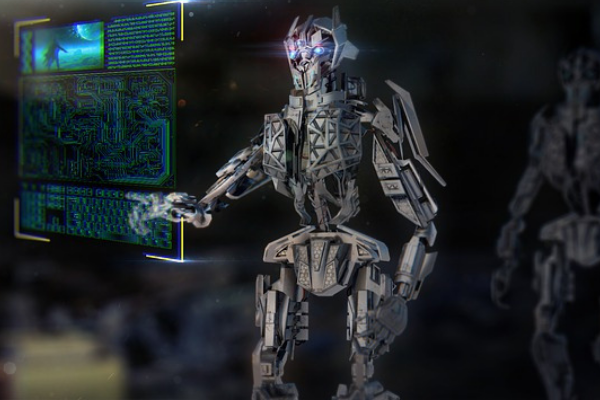
A Question Answered
What is Singularity?
Read a summary using the INOMICS AI tool
Singularity is a concept that began as a way to describe a mathematical phenomenon. In mathematics, it refers to a point where a mathematical object or point in a function set, begins to behave in an unusual, undefined or chaotic way. For instance, the function f(x) = 1/x becomes undefined at x=0, the function becomes plus or minus infinity, so this point is known as the singularity of the function. Keeping this mathematical construct in mind, this article will explore the use of singularity in mechanics and the more recent concept of ‘technological singularity’.

Mechanical Singularity
Mechanical singularity is closely related to mathematical singularity. If a mechanical system or machine exhibits chaotic behaviour or a position in which physical quantities cannot be determined (nondeterministic), then it is said to display mechanical singularity. If a singular position or configuration of mechanical parts exists, then the engineering equations can be analysed and they will display mathematical singularity at that point.
The gimbal lock mechanism is a good example of mechanical singularity in action. A gimbal is a ring suspended in such a way as to allow rotation about an axis. In the gimbal lock system, three such rings are arranged in a parallel configuration often used in gyroscopes. The gimbal lock system reaches singularity at a pitch angle of +/- 90o, due to the definition of Euler angle, the roll and yaw of the other two gimbals are undefined values, hence it is in mathematical singularity.
Suggested Opportunities
- Conference
- Posted 4 days ago
EcoMod2026 International Conference on Economic Modeling and Data Science
Between 8 Jul and 10 Jul in Esch-sur-Alzette, Luxembourg
- Online Course
- (Online)
- Posted 4 days ago
Python and Statistics for Financial Analysis
at Hong Kong University of Science and Technology and Coursera in Hong Kong SAR China
Technological Singularity
Another commonly used definition is technological singularity. It refers to the hypothesis that artificial superintelligence (ASI) could create technological growth on a massive scale, having far-reaching effects on the world and the way we live. The concept of technological singularity has its roots in futurism, but has been explored by mainstream scientists in recent years.
A commonly explored theory is that an advanced computer capable of self-upgrading with artificial general intelligence software could enter a ‘runaway reaction’ of iterative self-improvement cycles, with increasingly rapid intervals. A singularity would eventually be reached resulting in infinite intelligence growth (think of the reciprocal graph of f(x)=1/x), resulting in a superintelligence that far surpasses anything conceivable to human beings. In recent years, popular scientists such as the late Stephen Hawking and well-known inventor Elon Musk have posited that the rate of technological change could result in human extinction. Technological singularity is often pointed to as a potential cause of a cataclysmic event that could trigger extinction.
The idea of technological singularity originated with Vernor Vinge, a computer science professor and science fiction author, also agrees that it could signal the end of human civilisation as we know it. A superintelligence would advance at an incomprehensible rate with inconceivable consequences. However, academics are divided on the plausibility of such an event. Many point to the exponential growth of computing technology as following Moore’s Law, which would indicate that we are close to reaching a singularity. Computer scientist, author and inventor Ray Kurzweil has gone as far as predicting a date, the year 2045, in line with many other academic’s predictions, ranging between 2040 and 2050.
Kurzweil also elaborates on what the singularity is likely to mean for humans, saying that as a superintelligence reaches singularity there will be no discernible difference between human and machine, allowing humans to transcend the limitations of our biology. This utopian view stands in contrast to the more pessimistic outlook of many scientists and futurists. On the other hand, there are some noteworthy and vocal critics of the technological singularity hypothesis. Steven Pinker, for example, has been quoted as saying,
“There is not the slightest reason to believe in a coming singularity. The fact that you can visualize a future in your imagination is not evidence that it is likely or even possible. Look at domed cities, jet-pack commuting, underwater cities, mile-high buildings, and nuclear-powered automobiles—all staples of futuristic fantasies when I was a child that have never arrived. Sheer processing power is not a pixie dust that magically solves all your problems.”
Summary
There is no disputing mathematical and mechanical singularity, they are verifiable points within a set or system that behave in an indeterminate or chaotic manner. Technological singularity is a more contentious hypothesis. Will an artificial superintelligence surpass human intelligence and destroy the world as we know it? The truth is: only time will tell. As with many predictions of the future, it hinges on some analysis of data, some mathematical observations and plenty of educated guesswork.
-
- Conference
- Posted 4 days ago
EcoMod2026 International Conference on Economic Modeling and Data Science
Between 8 Jul and 10 Jul in Esch-sur-Alzette, Luxembourg
-
- Graduate / Traineeship Job
- Posted 1 week ago
Digital IC Design Engineer (EP-ESE-ME-2025-225-GRAP)
At CERN in Genève, Switzerland -
- Practitioner / Consultant Job
- Posted 1 week ago
Electrical Design Engineer
At CV-Library in London, United Kingdom












